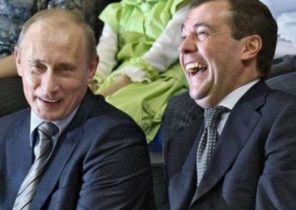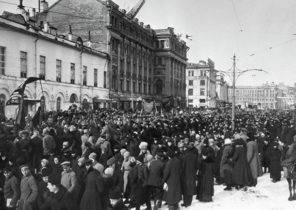
This week, the Pentagon officially launched a review and revision of the status of its nuclear capability. By year-end procedure will end and the President will give a detailed report and recommendations. The evaluation was initiated by Donald trump back in January of this year. The goal is to test how the nuclear capabilities of the United States meet modern threats and challenges in the face of Russia, China, Iran and North Korea.
Vice-Chairman of the joint chiefs of staff, General Paul Selva believes that the assessment of capacity will allow to formulate a strategy of response to those countries that allow the rhetoric about the willingness to use nuclear weapons. We are talking about Russia. Earlier the General Selva also accused Russia of deploying land-based missiles prohibited by the Treaty on the elimination of intermediate-range nuclear forces (INF): “the system Itself poses a risk to most of our facilities in Europe. And we believe that Russia is deliberately unfolded it to create a threat to NATO and objects in the area of responsibility of NATO.” According to Selva, to the end of the year in USA will find the solution that is possible to oppose Russia.
While there will be evaluation of the nuclear potential of the United States, actively working on the creation of tactical low-yield nuclear weapons that may be the anticipated response of Russia, not entailing a full-fledged Intercontinental nuclear war.
In April it became known that in the USA, tested to the latest modification of nuclear bombs B61-12. Tests were conducted without a nuclear warhead and to reset this bomb was used F-16 aircraft. B61-12 hits the target with accuracy from 5 to 30 meters (with the unavailability of the GPS signal) and the radius of the crater after it hit is also about 30 meters. A nuclear warhead can be from 0.3 to more than 300 kilotons. Tests of the B61-12 has been underway for two years, and in 2020 should begin its production and subsequent admission to the armed forces, including in Europe. In the fall of 2016, by the way, also tested other upgraded managed nuclear bombs B61-7 and B61-11.
The big resonance was caused by the recent use of the “mother of all bombs” by the Americans in Afghanistan April 13. Formally the most powerful non-nuclear bomb the US dropped on the tunnels of the “Islamic state” (organization banned in Russia — approx. ed.) but, according to, for example, Business Insider, the use of such weapons is a message not so much North Korea or Assad in Syria, as all the “unfriendly and aggressive” countries that are potential adversaries of the United States that Americans are ready to raise rates in local conflicts. In order to use this specific ammunition the Pentagon, according to The New York Times, didn’t even need a personal endorsement of Donald trump. Such decisions of the military under the new US administration to make.
Jason Ditz (Jason Ditz) is concerned about the application and testing of powerful bombs. His logic is: the use of new types of weapons (for example, drums, drones) starts gently and gradually, but then it becomes commonplace and is gaining momentum.
With the same drones after the first strike in 2001 over 16 years underwent radical changes. Now they are used in almost every conflict involving the United States, more and more countries acquire Chinese attack drones, many countries seek as quickly as possible to develop its attack drones. In the end, this type of arms that is associated with a lot of “collateral damage” among the civilian population and the attacks “suspect”, does not cause loud protests.
Jason Dietz is afraid that with tactical nuclear bombs will be the same. The US decides to use them against militants in a country of the Third world using a low nuclear charge. Crater with a radius of 30 meters — it is, after all, seem not so scary? The media, of course, after the first application will be to rant and rave, human rights defenders will be shocked, other countries will formally condemn the use. But the second time using the same nuclear B61-12 will not cause such a reaction. And use that here and there low-yield tactical nuclear bombs in different theatres of war in which the U.S. does not know scarcity, would soon become routine. The hype will subside. And charging capacity will gradually rise. And soon it will be possible to justify the use of 50 kilotons against “specially fortified” defensive structures anywhere in Yemen, Somalia, Libya and Afghanistan. Or against large concentrations of fighters. During the “Gulf War”, for example, the Americans believed that the destruction of one division of Saddam Hussein, we need to spend 17 tactical nuclear bombs. Dick Cheney (Dick Cheney) said then that the nuclear “Genie” will not let out of the bottle, but the theoretical consequences of such actions should be carefully examined.
Will decrease and the psychological threshold of using nuclear weapons, which does not lead directly to polnomasshtabnoy war between the major powers. But it is a step in this direction.
General Norton Schwartz (Norton Schwartz), former chief of staff, U.S. air force, once said that the enemy must understand that America has a high-precision tactical nuclear weapon with a small release of radiation and with the least possible “collateral losses” for the civilian population. According to Schwartz, the availability and willingness of States to use such weapons is an important factor of nuclear deterrence in the world, but General James Cartwright (James Catwright), the former head of Strategic command of the armed forces of the United States, believes that it is necessary frankly to admit that the presence of a low-power charge with a reduced release of radiation increases the likelihood of its use.
While the US began to reassess its nuclear policy and Arsenal, in the foreign media there are materials that in Russia want to arm the tank of the third generation T-14 nuclear warheads. According to Philip Kubera, head of the Fund “Potomac” Russia creates the “atomic tank”, is actively working to subkiloton shells and fulfills their theoretical use during exercises on the border with Ukraine. Moreover, according to the military expert, Russia has maintained from 2 to 5 thousand tactical nuclear warheads, while the United States retained only a few units.
Popular Mechanics also says that how can a tank destroy the nuclear subkiloton Russian shell with a capacity of 500 tons, and suggests that Russia has many tactical nuclear warheads that there is no sense to develop new tanks, although it is possible.
Major General USA, William Hicks also warns that once informed the Soviet generals were against the use of tactical nuclear weapons, but today, the military of Putin “philosophically more inclined to see their usefulness”.







